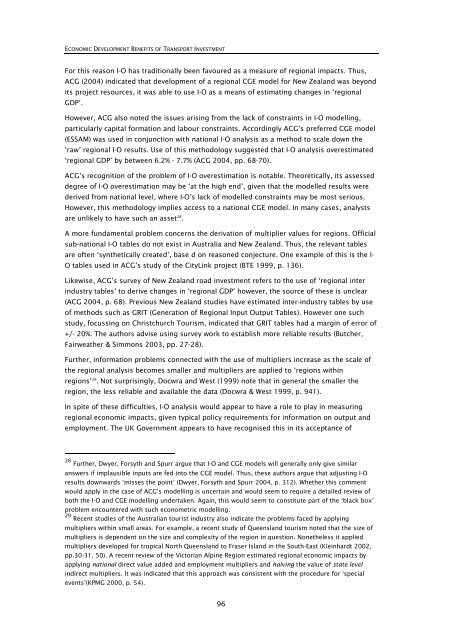Research 350 - NZ Transport Agency
Research 350 - NZ Transport Agency
Research 350 - NZ Transport Agency
Create successful ePaper yourself
Turn your PDF publications into a flip-book with our unique Google optimized e-Paper software.
ECONOMIC DEVELOPMENT BENEFITS OF TRANSPORT INVESTMENT<br />
For this reason I-O has traditionally been favoured as a measure of regional impacts. Thus,<br />
ACG (2004) indicated that development of a regional CGE model for New Zealand was beyond<br />
its project resources, it was able to use I-O as a means of estimating changes in ‘regional<br />
GDP’.<br />
However, ACG also noted the issues arising from the lack of constraints in I-O modelling,<br />
particularly capital formation and labour constraints. Accordingly ACG’s preferred CGE model<br />
(ESSAM) was used in conjunction with national I-O analysis as a method to scale down the<br />
‘raw’ regional I-O results. Use of this methodology suggested that I-O analysis overestimated<br />
‘regional GDP’ by between 6.2% - 7.7% (ACG 2004, pp. 68-70).<br />
ACG’s recognition of the problem of I-O overestimation is notable. Theoretically, its assessed<br />
degree of I-O overestimation may be ‘at the high end’, given that the modelled results were<br />
derived from national level, where I-O’s lack of modelled constraints may be most serious.<br />
However, this methodology implies access to a national CGE model. In many cases, analysts<br />
are unlikely to have such an asset 28 .<br />
A more fundamental problem concerns the derivation of multiplier values for regions. Official<br />
sub-national I-O tables do not exist in Australia and New Zealand. Thus, the relevant tables<br />
are often ‘synthetically created’, base d on reasoned conjecture. One example of this is the I-<br />
O tables used in ACG’s study of the CityLink project (BTE 1999, p. 136).<br />
Likewise, ACG’s survey of New Zealand road investment refers to the use of ‘regional inter<br />
industry tables’ to derive changes in ‘regional GDP’ however, the source of these is unclear<br />
(ACG 2004, p. 68). Previous New Zealand studies have estimated inter-industry tables by use<br />
of methods such as GRIT (Generation of Regional Input Output Tables). However one such<br />
study, focussing on Christchurch Tourism, indicated that GRIT tables had a margin of error of<br />
+/- 20%. The authors advise using survey work to establish more reliable results (Butcher,<br />
Fairweather & Simmons 2003, pp. 27-28).<br />
Further, information problems connected with the use of multipliers increase as the scale of<br />
the regional analysis becomes smaller and multipliers are applied to ‘regions within<br />
regions’ 29 . Not surprisingly, Docwra and West (1999) note that in general the smaller the<br />
region, the less reliable and available the data (Docwra & West 1999, p. 941).<br />
In spite of these difficulties, I-O analysis would appear to have a role to play in measuring<br />
regional economic impacts, given typical policy requirements for information on output and<br />
employment. The UK Government appears to have recognised this in its acceptance of<br />
28 Further, Dwyer, Forsyth and Spurr argue that I-O and CGE models will generally only give similar<br />
answers if implausible inputs are fed into the CGE model. Thus, these authors argue that adjusting I-O<br />
results downwards ‘misses the point’ (Dwyer, Forsyth and Spurr 2004, p. 312). Whether this comment<br />
would apply in the case of ACG’s modelling is uncertain and would seem to require a detailed review of<br />
both the I-O and CGE modelling undertaken. Again, this would seem to constitute part of the ‘black box’<br />
problem encountered with such econometric modelling.<br />
29 Recent studies of the Australian tourist industry also indicate the problems faced by applying<br />
multipliers within small areas. For example, a recent study of Queensland tourism noted that the size of<br />
multipliers is dependent on the size and complexity of the region in question. Nonetheless it applied<br />
multipliers developed for tropical North Queensland to Fraser Island in the South-East (Kleinhardt 2002,<br />
pp.30-31, 50). A recent review of the Victorian Alpine Region estimated regional economic impacts by<br />
applying national direct value added and employment multipliers and halving the value of state level<br />
indirect multipliers. It was indicated that this approach was consistent with the procedure for ‘special<br />
events’(KPMG 2000, p. 54).<br />
96
















